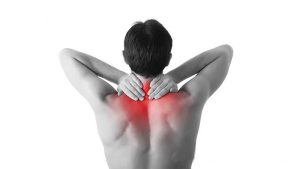When you hear the term “slipped”, “ruptured” or “bulging” disc, what this actually means is a herniated disc – a common cause of pain in the neck, lower back, arms, or legs.
Discs anatomy
Found between the hard bones (vertebrae) that comprise the spinal column, discs are soft, rubbery pads. The discs between the vertebrae enable the back to flex or bend and also act as shock absorbers.
Herniated disc causes
A disc herniates or ruptures when part of the centre nucleus pushes through the periphery of the disc and back toward the spinal canal. This places pressure on the nerves, or in the disc itself, resulting in 2 possible types of pain:
Pinched nerve – When the disc itself is not painful, but rather the material that is leaking out of the inside of the disc is pinching or irritating a nearby nerve. This type of pathology produces pain called radicular pain leading to pain that may radiate to other parts of the body, such as from the low back down the leg or from the neck down the arm. A pinched nerve causing leg pain is usually described as sciatica.
Disc pain – When the disc space itself is painful and the source of pain. This type of pain is typically called axial pain.
Either of the above two conditions can occur in the cervical (neck), thoracic (upper), or lumbar (lower) spine. However, they tend to be most common in the lower back because it bears the most torque and force on a day to day basis.
Herniated disc risk factors
In children and young adults, discs have high-water content. As we get older, the water content in the discs reduces and the discs become less flexible. The discs start to shrink and the spaces between the vertebrae get narrower. Conditions that can fasten the degeneration:
-
- Improper lifting
- Smoking
- Excessive bodyweight that places added stress on the discs, particularly in the lower back
- Sudden pressure (which may be slight)
- Repetitive strenuous activities
Lower back herniated disc symptoms
-
- Sharp, shooting pain that extends from the buttocks down the back of one leg is the most common symptom.
- Weakness in one leg
- Tingling (“pins-and-needles” sensation) or numbness in one leg or buttock
- A burning pain centered in the back
Herniated disc treatment
Chiropractic treatment can help patients with herniated discs. The primary goal is to help relieve pain and other symptoms resulting from the herniated disc. To achieve this goal, each Chiro & Sports Med patient’s treatment plan is individualized, based on the source of the pain, the severity of pain, and the specific symptoms that the patient exhibits.
There are also a few things that you can do yourself:
- Apply cold compresses or ice a couple of times a day for 20 minutes at a time.
- After any spasms settle, gentle heat applications can be employed.
- Any physical exercise needs to be slow and controlled, particularly bending forward and lifting. This will help to ensure that symptoms do not return. As can taking short walks and avoiding sitting for long periods. Further, to avoid future episodes of pain, it is important that you be instructed in how to properly stand, sit, and lift.
- Muscle relaxers and anti-inflammatory medications can be helpful.
- If, however, these nonsurgical treatment measures fail, cortisone injections may lessen nerve irritation and enable more effective participation in chiropractic treatment. Ask your practitioner about it.
If you would like to make an appointment with one of the chiropractors at Chiro & Sports Med simply call our office on 9817 2005 and one of our friendly staff will organize an appointment for you.





